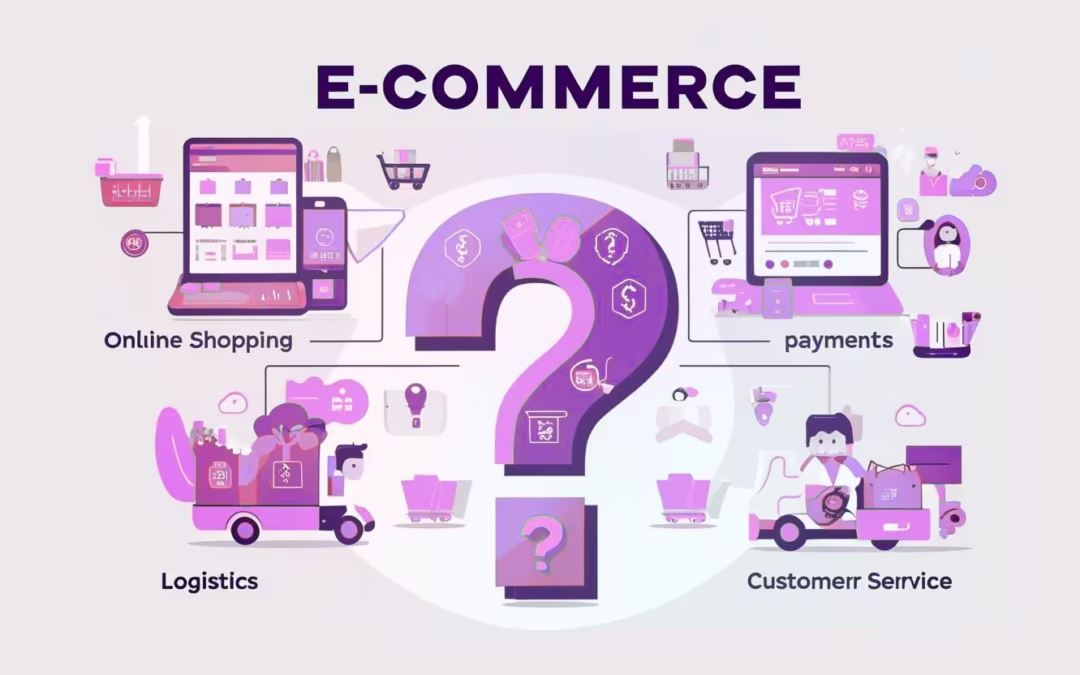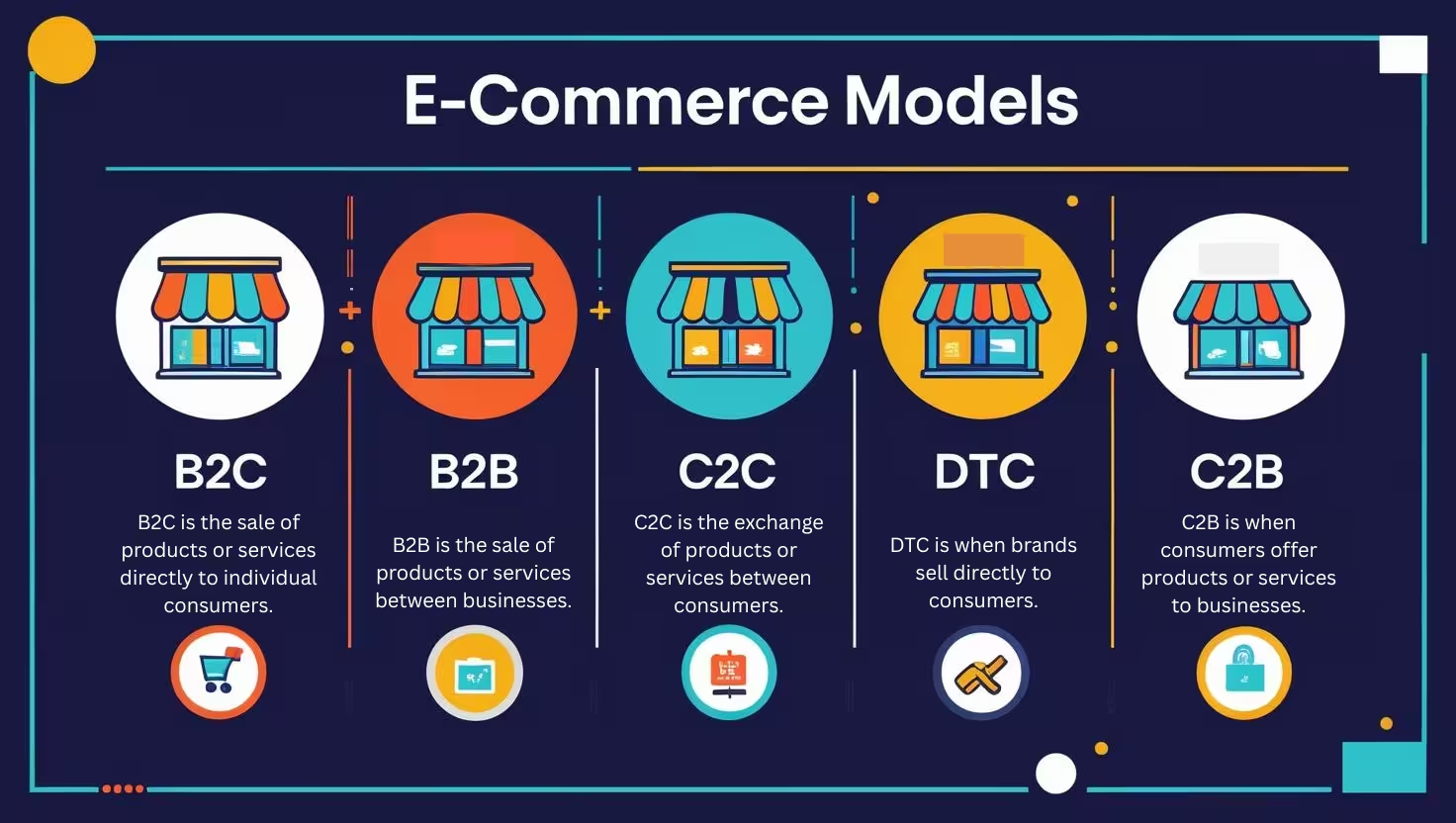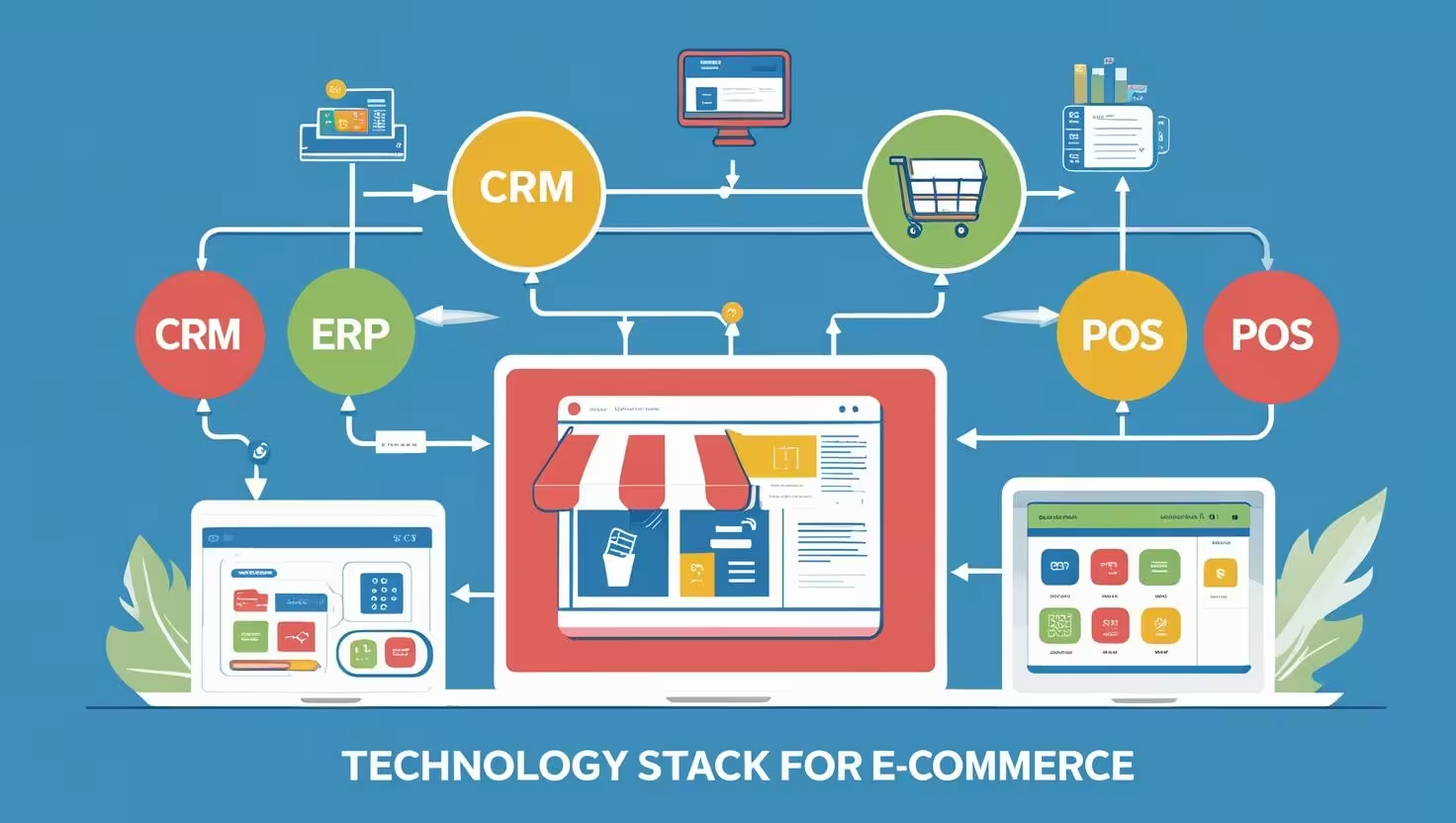
What is ecommerce?
Our way of buying and selling has completely changed compared to the previous era. If we look back at the previous years, how was shopping? Going to the store, waiting in long lines, not getting the desired items, and getting rubbish quality in the name of brands. We had to go through such problems. But today it is not like that because in the fast-paced era, shopping can be done in a few days and hours, that too from your phone and from your favorite brand and this thing is called e-commerce.
This is the power of e-commerce.
But what exactly is e-commerce, how does it work, and what is e-commerce? Why is it a game changer for businesses? And why should every business be online in this era? Even if you are a layman and don’t know how online business works or how it thrives, this guide is made just for you. That too in simple and easy language.
What is e-commerce?
It is essentially the buying and selling of goods and services over the internet — a model that has revolutionized the way we do business and do business. The role of e-commerce in 2025 is even more important. With more than 5.5 billion users worldwide and e-commerce sales of more than $6.3 trillion worldwide, it is true that digital commerce is no longer just a convenience; it is the backbone of modern businesses. Consumers now expect seamless online shopping, personalized ordering, and fast, reliable delivery, putting pressure on businesses to simplify and improve every step of the customer journey. The role of e-commerce in 2025 goes far beyond transactions — it is central to brand recognition, customer engagement, and long-term growth.
Why e-commerce matters in today’s world.
E-commerce isn’t just a trend — it’s a modern way of doing scale& big business.
Here’s why it’s more important than ever:
Customers shop online every day because they now expect convenience, speed, and variety. People want to do everything from their smartphones, right from the comfort of their homes.
You don’t need a huge investment to start an online store. Even small businesses are coming online and are now competing with big brands.
Unlike physical stores, e-commerce has no boundaries. You can sell anything to anyone, anywhere.
Every online Customers gives you valuable information about your customer’s preferences, which helps you improve and grow.

How many types of e-commerce models are there?
Not every e-commerce business works the same way. Here are the most common models that describe how buyers and sellers interact online:
1. Business-to-consumer (B2C)
This is the most common type. Essentially, the business is dealing with and serving the consumer. A business sells products or services directly to individual
customers. Examples: clothing brands, electronics stores, or online food delivery.
2. Business-to-business (B2B)
This is the core of B2B. Businesses are the customers, not individual consumers.. For example, This is common in B2B, especially in white labeling or OEM (Original Equipment Manufacturer) arrangements. Think of A wholesale supplier selling raw materials to a manufacturer, or A software company offering tools to digital agencies.
3. Consumer to Consumer (C2C)
This is a business where consumers sell goods or services directly to other consumers, usually through online platforms. Websites like OLX, Facebook Marketplace, and eBay, etc. limit their reach to those consumers who need their products.
4. Direct to Consumer (DTC)
Those who sell their products directly to consumers, meaning that the manufacturer markets their product themselves and sells it directly to consumers. In DTC, the consumer gets both the product and the pricing because in this, everyone gets a side, who delivers the product to the consumer by keeping their profit or commission. Very common DTC formats. Characters like Dollar Shave Club, Shiny, and Hello Fresh follow this.
5. Consumer to Business (C2B)
Yes, this business is also very common but very few people know about it, such as, individuals offering businesses or services. For example, freelancers or influencers who work.

Tools and Tech That Power Ecommerce
Starting an e-commerce business today requires more than just a great product and a great website – it demands the right technology stack to stay organized, efficient, and customer-centric. As online business continues to grow in 2025, businesses should take advantage of smart tools that support both growth and a seamless customer experience.
Customer Relationship Management (CRM):
An e-commerce business only succeeds when it understands and values its customers. A robust CRM system helps track customer behavior, preferences, and purchase history, improving personalized marketing, better service, and long-term loyalty. Platforms like HubSpot or Salesforce can turn customer data into actionable insights.
Enterprise Resource Planning (ERP):
As your operations expand, juggling inventory, orders, and financial data across multiple systems becomes inefficient and risky. ERP software brings everything together—inventory management, order fulfillment, accounting, and even supplier coordination—into one central platform. This integration is critical to maintaining accuracy and efficiency, especially at scale.
Point of Sale (POS) System:
When you’re running both an online store and a physical location, keeping everything in sync can quickly get messy. That’s where a good POS system comes in. It connects your in-store and online sales, so your inventory updates automatically, no matter where the purchase happens. This means customers won’t get frustrated by finding something online that’s actually out of stock. It also helps make the checkout process simple and consistent—whether someone’s buying from your website at midnight or standing at your counter during business hours.
Product Feed Management:
Selling across multiple platforms—like Google Shopping, Amazon, Facebook, and Instagram—requires consistently accurate and optimized product data. Product feed management tools automate the process of formatting, updating, and distributing product listings, helping your brand stay on top and competitive across all sales channels.
Together, these e-commerce technologies create a strong operational foundation. Choosing the right tools isn’t just about automation—it’s about building an efficient, scalable business that can compel consumers to buy and stay competitive in a fast-paced digital landscape.
Why More Entrepreneurs Are Choosing E-commerce Over Traditional Retail
In recent years, e-commerce has evolved from a convenience to a strategic advantage. For business owners looking to scale sustainably, reach broader audiences, and maintain tighter control over operations, online commerce offers unique opportunities that go far beyond the surface-level perks often touted in generic blogs.
1. Continuous Availability Meets Changing Consumer Behavior
Unlike brick-and-mortar stores with fixed hours and location-based foot traffic, e-commerce platforms are accessible around the clock. But the real value isn’t just being “open 24/7”—it’s about meeting customers where they already are: online. With mobile-first shopping habits, voice search trends, and demand for frictionless purchasing, e-commerce ensures your business is aligned with modern buyer expectations.
2. Cost Efficiency With Strategic Control
Operating an e-commerce business removes several fixed costs—there’s no need for physical retail space, high utility bills, or in-person staff at every location. But the real benefit lies in how that cost efficiency allows reinvestment into areas that drive growth: paid traffic, customer retention strategies, and supply chain optimization. Smart ecommerce operators often leverage this flexibility to test and refine offers without incurring significant overhead.
3. Scalability without geographic constraints
One of the most compelling aspects of e-commerce is its built-in scalability. Unlike physical retail, which often requires new storefronts, store construction, and logistical headaches to expand, you can easily scale an online business through digital infrastructure—think automation tools, third-party logistics, and local websites. This makes it easier to grow strategically, whether you’re targeting regional locations or expanding globally.
4. Borderless Access to Emerging Markets
E-commerce breaks down the traditional geographic barriers that limit physical stores. Whether you’re a local artisan or a large manufacturer, you have the ability to reach buyers in international markets with minimal friction. Tools like localized currency settings, multilingual sites, and international shipping integrations make cross-border ecommerce more accessible than ever—and with the right strategy, it becomes a powerful growth lever.
5. Data-driven decision-making
One of the most widely used benefits of e-commerce is access to precise customer data. Every interaction — clicks, purchases, cart abandonment — is tracked, and it can be translated into a table format to gauge whether the customer is interested in our product. Businesses that leverage this data can personalize marketing, improve the user experience, and make better decisions about inventory and pricing. Over time, this creates a more responsive, profitable operation based on real-time feedback.
The Real-World Challenges of Running an Ecommerce Business—and How to Navigate Them
E-commerce presents tremendous opportunities, but it’s not without its operational and strategic hurdles. Successful online retailers understand that growth isn’t just about launching a store—it’s about solving real problems consistently as your business scales. Below, we explore some of the most critical challenges ecommerce businesses face, with insights that go beyond surface-level commentary.
1. Website performance directly impacts revenue.
A slow-loading site or unexpected downtime can lead to traffic loss to your website and a website not ranking well on search engines – research shows that even a one-second delay in page load time can reduce conversions by up to 7%. Maintaining a high-performance infrastructure, implementing caching strategies, and using a reliable hosting provider are not just technical considerations – they are business imperatives.
If I may tell you in more detail, e-commerce sites require ongoing optimization on both mobile and desktop platforms. With Google prioritizing core web vitals in its ranking algorithm, performance has become a measurable SEO factor, not just a user experience concern.
2. Returns, Refunds, and Customer Experience Are Operational Pressure Points
Returns are a natural part of ecommerce, especially in categories like fashion, electronics, and home goods. However, poor handling of return logistics or vague refund policies can lead to negative reviews, loss of repeat customers, and reputational damage.
A transparent, user-friendly return process not only builds trust but also reduces friction in the buyer’s journey. Sophisticated ecommerce operations often integrate return management systems that automate RMA (Return Merchandise Authorization), track return reasons, and feed insights back into product development and inventory decisions.
3. Shipping delays and fulfillment complications can erode trust.
Fast, reliable delivery is no longer a luxury—it’s a hallmark of every successful business. But achieving it requires more than consistently choosing the cheapest shipping provider. Inventory forecasting, warehousing, third-party logistics (3PL) partnerships, and last-mile delivery coordination all play a role in whether an order reaches a customer on time.
Here are some of the reasons why orders are being delayed: Delays due to customs hurdles or fulfillment errors can turn loyal customers into lost revenue. E-commerce businesses need robust order tracking, proactive communication, and contingency plans for peak seasons and international shipping.
4. Standing out in a crowded marketplace requires strategic positioning.
With low barriers to entry, e-commerce has rapidly expanded across most verticals. Simply launching a product is no longer enough—brand identity, storytelling, and customer experience now play a decisive role in purchasing decisions.
The most successful e-commerce brands invest heavily in long-term positioning. This includes having a unique value proposition (UVP), leveraging content marketing to tell people about and make them aware of their product rather than just selling it, and maintaining consistent brand messaging across every digital touchpoint—from social ads to email campaigns to packaging.
5. Cybersecurity and data privacy are ongoing responsibilities.
E-commerce businesses handle sensitive information every day — like credit card numbers, addresses, purchase history, and login credentials. This makes them a prime target for cybercriminals. A single breach can result in financial losses, regulatory fines, and lasting damage to customer trust.
Compliance with data protection regulations like GDPR, CCPA, and PCI-DSS is non-negotiable. In addition to compliance, e-commerce platforms should implement multi-layered security: SSL encryption, regular vulnerability testing, secure payment gateways, and two-factor authentication.
Trust isn’t earned through product quality alone — it’s reinforced through responsible data stewardship.
Is E-commerce Right for You?
If you have a product or service to offer—and the willingness to learn—ecommerce is one of the most rewarding paths to grow a business in today’s digital world. From freelancers to large brands, ecommerce levels the playing field and lets creativity shine.
You don’t have to know everything at once. Start small, test, learn from your customers, and improve over time. The beauty of ecommerce is that you can adjust as you grow.
Final Thoughts
E-commerce isn’t just about selling products online — it’s about creating experiences, solving problems, and reaching people across borders. Whether you’re launching your first product or scaling your store globally, e-commerce opens doors that traditional retail simply can’t.
The future of commerce is digital. And it’s waiting for you.
1. What is ecommerce and how does it work?
Ecommerce refers to buying and selling products or services online. It works by using a website or app where customers can place orders, make payments, and have items delivered to their door.
2. What are the benefits of starting an ecommerce business?
Ecommerce offers low startup costs, global reach, 24/7 availability, and the ability to track customer behavior for better marketing and sales decisions.
3. Do I need a website to start selling online?
Yes, having your own ecommerce website gives you full control over branding, customer experience, and long-term business growth. However, you can also start by selling on platforms like Amazon or Etsy.
4. What is the difference between B2B and B2C ecommerce?
B2B (Business-to-Business) e-commerce involves selling to other companies, while B2C (Business-to-Consumer) refers to selling directly to individual customers.
5. Is ecommerce profitable for beginners?
Yes, with the right strategy, product, and marketing, e-commerce can be profitable—even for beginners. Starting small and learning from data is key.
6. What are the most popular ecommerce platforms?
Top ecommerce platforms include Shopify, WooCommerce, BigCommerce, and Wix. Your choice depends on your technical skill, budget, and store size.
7. How do I accept payments on my ecommerce store?
You can accept payments through gateways like Stripe, PayPal, local bank integrations, or even cash on delivery, depending on your location and customer preference.
8. How do I attract traffic to my ecommerce site?
Utilize a combination of SEO, social media marketing, email campaigns, content marketing, and paid ads. Make sure your site is fast, mobile-friendly, and optimized for conversions.
9. What legal requirements should I consider for ecommerce?
You’ll need to handle taxes, privacy policies, refund policies, and terms of service. Depending on your country, registration and compliance may also be needed.
10. Can I run an ecommerce business without holding inventory?
Yes, with dropshipping, you sell products directly from a supplier without stocking them. This model lowers startup costs but may reduce profit margins.

Recent Comments